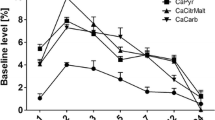Abstract
Elemental calcium plays an important role in human physiology. In order to study the relationship between Ca-intake, Ca-chemical formulation, and Ca-absorptivity, a balance experiment using a 41Ca tracer technique in SD rats was conducted to measure the endogenous fecal calcium and true absorption of calcium. Apparent absorption of calcium was measured as a control to the endogenous calcium labeling experiment. These results show that by using 41Ca labeled endogenous calcium in vivo, researchers could obtain the true calcium absorption data without extrinsic labeling. Therefore, the method was not affected by the chemical structure or type of calcium supplement and might be used in evaluating the absorptivity of marketed calcium supplements.


Similar content being viewed by others
References
J. Purkiss, M. Welch, S. Doward et al., Capsaicin-stimulated release of substance P from cultured dorsal root ganglion neurons: involvement of two distinct mechanisms. Biochem. Pharmacol. 59, 1403–1406 (2000). https://doi.org/10.1016/S0006-2952(00)00260-4
Y.P. Xu, J.W. Zhang, L. Li et al., Complex regulation of capsaicin on intracellular second messengers by calcium dependent and independent mechanisms in primary sensory neurons. Neurosci. Lett. 517, 30–35 (2012). https://doi.org/10.1016/j.neulet.2012.04.011
J. Wang, Advance in the research of calcium in the prevention and treatment of osteoprosis. Chin J. Clin. Nutr. 12, 213–217 (2004). https://doi.org/10.3760/cma.j.issn.1674-635X.2004.03.016
Z.G. Wang, Preliminary discussion of related problems on supplemental calcium. Adverse Drug React. J. 8, 326–329 (2006). https://doi.org/10.3969/j.issn.1008-5734.2006.05.002. (in Chinese)
M.J. Bolland, P.A. Barber, R.N. Doughty et al., Vascular events in healthy older women receiving calcium supplementation: randomised controlled trial. BMJ 336, 262–266 (2008). https://doi.org/10.1136/bmj.39440.525752.be
M.J. Bolland, A. Avenell, J.A. Baron et al., Effect of calcium supplements on risk of myocardial infarction and cardiovascular events: meta-analysis. BMJ 341, c3691 (2010). https://doi.org/10.1136/bmj.c3691
M.R. Tadross, I.E. Dick, D.T. Yue, Mechanism of local and global Ca2+ sensing by calmodulin in complex with a Ca2+ channel. Cell 133, 1228–1240 (2008). https://doi.org/10.1016/j.cell.2008.05.025
G.N. Farhat, A.B. Newman, K.S. Tyrrell et al., The association of bone mineral density measures with incident cardiovascular disease in older adults. Osteoporosis Int. 18, 999–1008 (2007). https://doi.org/10.1007/s00198-007-0338-8
J.R. Southon, M.S. Bishop, G.J. Kost, 41Ca as a tracer for calcium uptake and deposition in heart tissue during ischemia and reperfusion. Nucl. Instrum. Method B. 92, 89–491 (1994). https://doi.org/10.1016/0168-583X(94)96060-7
H. Gu, S.R. Shi, L.L. Chang et al., Safety evaluation of daidzein in laying hens: part II. Effects on calcium-related metabolism. Food Chem. Toxicol. 55, 689–692 (2013). https://doi.org/10.1016/j.fct.2012.12.064
H.T. Shen, S. Jiang, M. He, Research on analysis methods for calcium absorptivity. Chin J. Osteoporosis Bone Miner Res. 2, 59–64 (2009). https://doi.org/10.3969/j.issn.1674-2591.2009.01.011. (in Chinese)
T. Matsumoto, T. Takano, S. Yamakido et al., Comparison of the effects of eldecalcitol and alfacalcidol on bone and calcium metabolism. J. Steroid Biochem. 121, 261–264 (2010). https://doi.org/10.1016/j.jsbmb.2010.03.035
S.P.H.T. Freeman, B. Beck, J.M. Bierman et al., The study of skeletal calcium metabolism with 41Ca and 45Ca. Nucl. Instrum. Method B. 172, 930–933 (2000). https://doi.org/10.1016/S0168-583X(00)00341-4
C.S. Kovacs, Calcium, phosphorus, and bone metabolism in the fetus and newborn. Early Hum. Dev. 91, 623–628 (2015). https://doi.org/10.1016/j.earlhumdev.2015.08.007
D. Elmore, M.H. Bhattacharyya, N.S. Gibson et al., Calcium-41 as a long-term biological tracer for bone resorption. Nucl. Instrum. Method B. 52, 531–535 (1990). https://doi.org/10.1016/0168-583x(90)90471-6
T.S. Rogers, M.G. Garrod, J.M. Peerson et al., Is bone equally responsive to calcium and vitamin D intake from food vs. supplements? Use of 41calcium tracer kinetic model. Bone Rep. 5, 117–123 (2016). https://doi.org/10.1016/j.bonr.2016.05.001
S.K. Hui, J. Prior, Z. Gelbart et al., A pilot study of the feasibility of long-term human bone balance during perimenopause using a 41Ca tracer. Nucl. Instrum. Method B. 259, 796–800 (2007). https://doi.org/10.1016/j.nimb.2007.02.003
C. Vockenhuber, T.S. König, H.A. Synal et al., Efficient 41Ca measurements for biomedical applications. Nucl. Instrum. Method B. 361, 273–276 (2015). https://doi.org/10.1016/j.nimb.2015.05.014
X.L. Zhao, A.E. Litherland, J. Eliades et al., Partial fragmentation of at low MeV energies and its potential use for 41Ca measurement. Nucl. Instrum. Method B. 294, 369–373 (2013). https://doi.org/10.1016/j.nimb.2012.01.046
L. Dou, M. He, K.J. Dong et al., Preliminary study of 41Ca-AMS measurement in rock samples. Atomic Energy Sci. Technol. 47, 2322–2326 (2013). https://doi.org/10.7538/yzk.2013.47.12.2322. (in Chinese)
H.T. Shen, F.F. Pang, S. Jiang et al., Study on 41Ca-AMS for diagnosis and assessment of cancer bone metastasis in rats. Nucl. Instrum. Method B. 361, 643–648 (2015). https://doi.org/10.1016/j.nimb.2015.05.034
M. He, X.D. Ruan, S.L. Wu et al., 41Ca analysis using CaF− in CIAE–AMS system. Nucl. Instrum. Method B. 268, 804–806 (2010). https://doi.org/10.1016/j.nimb.2009.10.035
Acknowledgements
We wish to thank experimentalist Lu Zheng from Beijing Union University for her help with the 41Ca biological tracer.
Author information
Authors and Affiliations
Corresponding author
Additional information
This work was supported by the National Nature Science Foundation of China (No. 11375272).
Rights and permissions
About this article
Cite this article
Zhang, H., Dou, L., Wang, XM. et al. Methodological study on endogenous calcium absorptivity using rats and 41Ca tracing. NUCL SCI TECH 29, 56 (2018). https://doi.org/10.1007/s41365-018-0387-z
Received:
Revised:
Accepted:
Published:
DOI: https://doi.org/10.1007/s41365-018-0387-z




